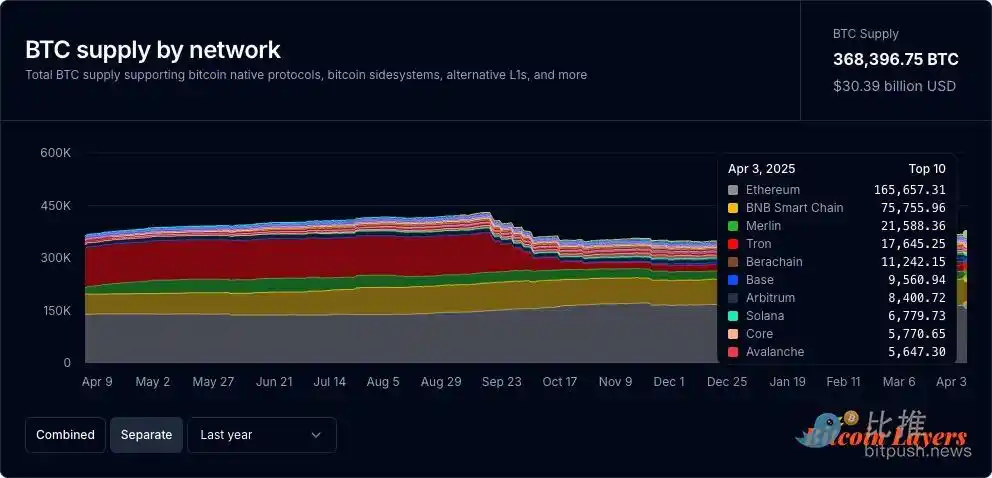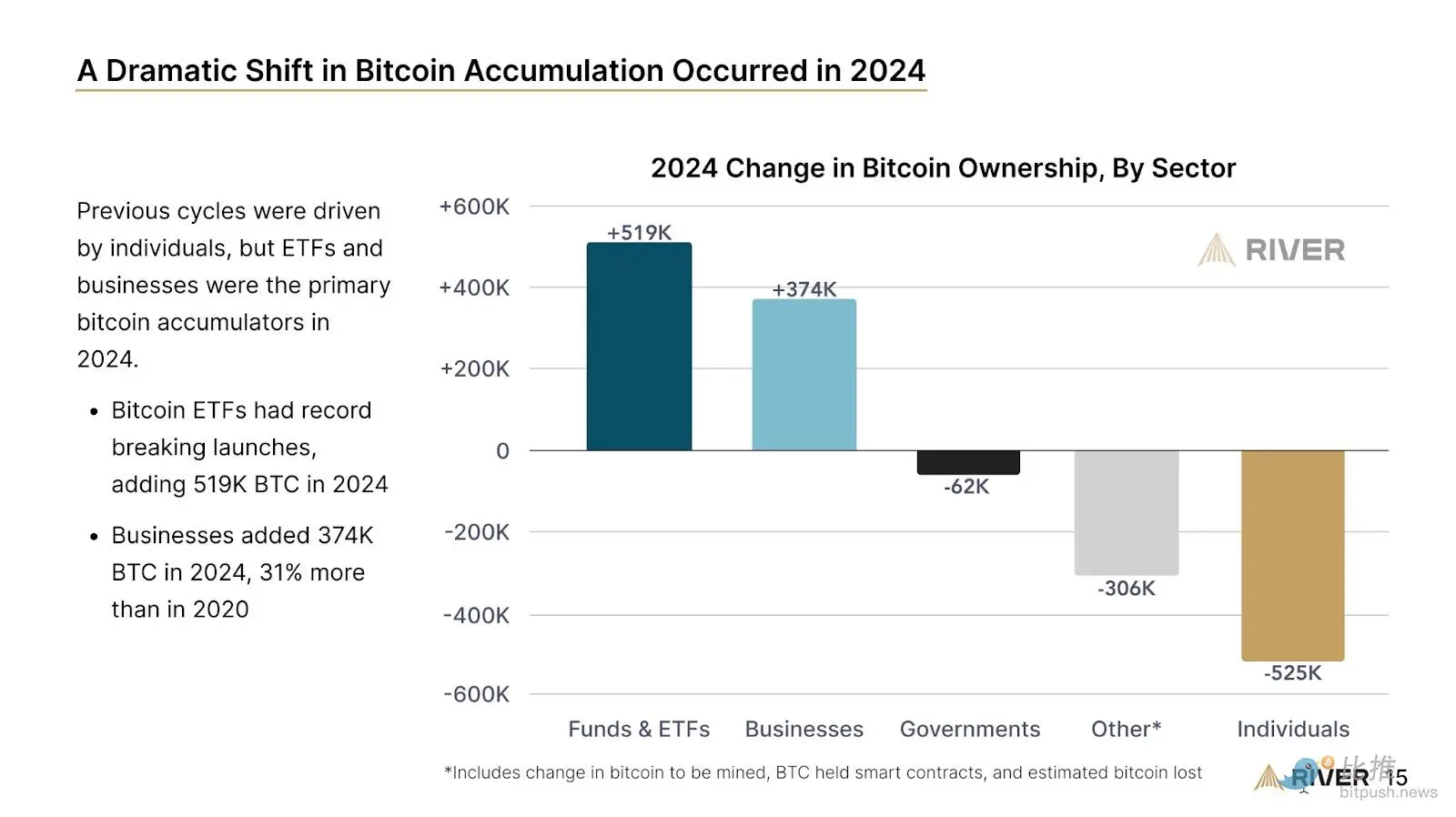30 billion BTC are sleeping outside the door of DeFi. Is on-chain development the key to breaking the deadlock?
Better user experience isn’t just nice to have, it’s critical infrastructure for the next phase of Bitcoin adoption.
Original title: Can Bitcoin Thrive Onchain?
Original article by Jean-Paul Faraj, Bankless
Original translation: BitpushNews
Despite its position at the top of the cryptocurrency market cap charts, Bitcoin’s relatively low participation in the decentralized finance (DeFi) space is sparking a deep discussion about its future role.
For more than a decade, Bitcoin has been a cornerstone of the crypto ecosystem — lauded for its decentralization, censorship resistance, and provable scarcity. However, despite its dominant market cap and recent resurgence in popularity, Bitcoin remains largely out of step with one of the most dynamic sectors in crypto: DeFi.
According to Bitcoin Layers, only about $30 billion of Bitcoin (just 1.875% of its total supply) is used in DeFi. In contrast, Ethereum has about $50 billion of ETH locked in DeFi, which is about 23% of its supply.
This gap highlights a core contradiction in the Bitcoin narrative today: while BTC holds tremendous value, relatively little BTC is actively utilized on-chain to provide yield opportunities. This gap is driving a wave of innovation around wrapping, staking, and other methods of bringing Bitcoin into the DeFi economy, unlocking ways to make BTC a productive capital asset.

Bitcoin Layers: BTC supply by network, showing all wrapped BTC
Ethereum’s DeFi ecosystem has already seen an explosion of tools for lending, staking, and trading. In contrast, native Bitcoin remains difficult to use effectively, especially for new users. Transaction times are slow, fees are variable and often high, and Bitcoin’s architecture lacks the programmability to power Ethereum-based applications.
As the broader cryptocurrency space matures, this raises an important question: Can Bitcoin meaningfully participate in the on-chain economy? If so, how do we bring average BTC holders on board without forcing them to go through a series of bridges, wrapped tokens, and unfamiliar applications?
Question: Bitcoin’s design and the practicality of DeFi
Bitcoin’s underlying architecture is not optimized for the high programmability of today’s smart contracts. It prioritizes security and decentralization through the Proof of Work (PoW) mechanism rather than pursuing complex logical expressions – this design choice makes it a reliable value storage tool, but also limits its adaptability in smart contracts and complex DeFi applications. Because of this, native Bitcoin is difficult to integrate into the booming composable financial ecosystem on public chains such as Ethereum and Solana.
We have seen some workarounds in the past:
Wrapped Bitcoin: Users convert BTC to ERC-20 tokens to access Ethereum-based DeFi. This introduces custody risk, as token liquidity may not be transparent and is not always backed 1:1 by BTC by a third-party custodian.
· Bridge protocols: Cross-chain platforms allow BTC to be transferred to other ecosystems. However, manual bridging adds friction, complexity, and risk — especially for non-technical users.
· Custodial Platforms: Centralized services like Coinbase offer BTC yield but require users to give up custody and often pay returns in points, stablecoins, or proprietary tokens rather than BTC.
Each option comes with trade-offs that challenge Bitcoin’s core ideals: security, simplicity, and user sovereignty.
Barriers to entry: Why user experience still matters

BTC accumulation in 2024, river.com
For Bitcoin holders who are curious about doing more with their assets (earning yield, participating in on-chain governance, or trying DeFi), the onboarding path remains fragmented, unintuitive, and often daunting. While the infrastructure has matured, the user experience still lags, and the competition is not only other blockchains, but also TradFi.
This friction creates a major barrier to entry. Most users don’t want to become DeFi power users — they want to simply and securely grow their net worth and BTC holdings without having to navigate the maze of apps, bridges, and protocols that have recently emerged as Bitcoin buyers making large off-chain purchases through brokers, ETFs, and products like Michael Saylor’s Strategy.
To convert the next wave of users from simple off-chain holders to on-chain users, tools need to remove this complexity without sacrificing control, self-custody, or transparency. This is where emerging protocols and modern wallet experiences really start to come into play – providing user-friendly access to DeFi infrastructure while keeping the core philosophy of Bitcoin intact.
Better user experience isn’t just nice to have, it’s critical infrastructure for the next phase of Bitcoin adoption.
On-chain BTC: A new method for earnings and productivity
Many emerging solutions aim to make Bitcoin more usable in DeFi — each with different tradeoffs:
1. Staking, re-staking and points-based income plans
Platforms like Babylon and Lombard now offer Bitcoin-related yield programs, often achieved through staking/re-staking, through points or reward tokens that are often redeemable for benefits or future airdrops. These systems are attractive to early adopters and crypto-native users chasing airdrops and platform-specific token economics. These products often involve converting BTC to wrapped BTC standard and then locking the assets in various programs/products to earn variable yields. For savvy on-chain traders, high yields can be obtained, but this requires a deeper understanding of how to use cryptocurrencies, as well as manually bridging, wrapping, and depositing funds.
advantage:
· Extensive revenue opportunities
Usually self-hosted
shortcoming:
Rewards are not paid in BTC
Usually requires a lock-up period
The long-term value of the reward is uncertain
2. Bitcoin Layer 2 and Meta Protocol
Developments like the Lightning Network, Rootstock (RSK), Alkanes, and emerging Layer 2s like Botanix and Starknet are bringing new functionality, programmability, and speed to Bitcoin. These innovations enable use cases like fast payments, NFTs, and smart contract-like behavior. As a result, users can now use their BTC to access a wide range of DeFi opportunities — such as securing the network by locking up funds, participating in market making, lending, or converting assets to support the Wrapped BTC standard on various protocols. As more teams build these networks, the ecosystem of Bitcoin-based yield opportunities will continue to expand.
advantage:
Expanding Bitcoin’s use cases
Consistent with Bitcoin’s architecture
Wide range of options for earning yield on-chain
shortcoming:
Still relatively early and fragmented
Requires intermediate to advanced understanding to utilize
· Significant developer resources are required to build out most of the utility that already exists on other smart contract chains
3. Smart Wallet Integration and Native BTC Earnings
Wallets like Braavos offer features that allow users to earn native BTC yields without having to manually wrap their Bitcoin or give up custody. Users can invest BTC directly through their wallets without having to deal with the usual hurdles of bridging or using external applications. Complex steps — such as deposits, wrapping, and bridging — are seamlessly handled in the background, and BTC is deployed into specific DeFi strategies. This user-friendly approach is designed to make BTC yields accessible to everyone, regardless of their technical background or cryptocurrency experience.
advantage:
Revenue is paid in BTC (not points or proxy tokens)
No manual bridging or third-party hosting required
Self-hosted by default
Beginner-friendly
shortcoming:
Depends on conversion to wrapped BTC
· Requires a certain level of trust in the bridging mechanism and yield protocol infrastructure
The bigger picture: Bitcoin’s evolving role on-chain
Bitcoin’s narrative has long been around “store of value” — a role it fulfills reliably. However, as the on-chain economy develops, pressure is growing for Bitcoin to integrate into this emerging financial stack and deliver on its promise as a reliable payment infrastructure.
To do this without sacrificing decentralization or user trust, new infrastructure must make these opportunities easily accessible without requiring technical expertise or abandoning Bitcoin’s core principles.
This means:
· Returns should be paid in BTC first, not derivative assets
Escrow must remain with the user
Complexity must be abstracted away, not transferred to the user
Products like Braavos, Lombard, Babylon, and the others mentioned in this article are all examples of how these ideas can be implemented. Whether by allowing users to earn yield through staking, or by embedding Bitcoin support directly into self-custody options and automating the complexity behind it, they are making DeFi more accessible to Bitcoin holders without requiring them to leave the Bitcoin ecosystem entirely.
Bridging the gap carefully
Bitcoin’s transition to an on-chain economy won’t happen overnight — nor should it. Caution, simplicity, and self-sovereignty are fundamental to Bitcoin’s core values. But as more tools emerge that respect these values and provide new capabilities, BTC’s role in the broader cryptocurrency economy is evolving.
The challenge now is to build systems that are open, secure, and most importantly, accessible. If the next billion users are to join through Bitcoin, they will need experiences that meet their existing needs and are accessible to the broader user base.
Author :比推BitPush
This article reflects the opinions of PANews’s columnist and does not represent the stance of PANews. PANews does not assume legal responsibility. The article and opinions do not constitute investment advice.
Image Source :
比推BitPush
If there is any infringement, please contact the author to remove it.